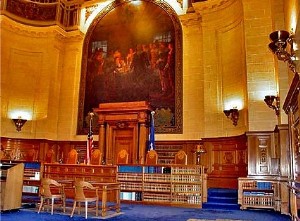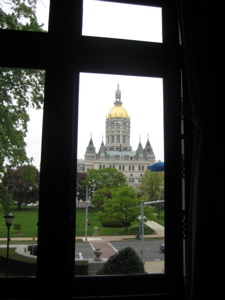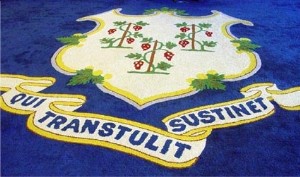Supremely Interesting
Hartford (Google Maps Location)
May 12, 2008
 While I have absolutely no factual basis upon which to state the following, I’m going to state it anyway: “Connecticut is the only state in the country where the state Supreme Court, State Library, and State History Museum are all housed under one roof.” So therefore a criminal can arrive early, check out some old Colt weaponry, stare at the portraits of past Governors, learn about the Charter Oak, read up on the legal history of his predicament, and then face the judge at court. Neat, huh? Let’s just hope the criminal didn’t steal one of those guns.
While I have absolutely no factual basis upon which to state the following, I’m going to state it anyway: “Connecticut is the only state in the country where the state Supreme Court, State Library, and State History Museum are all housed under one roof.” So therefore a criminal can arrive early, check out some old Colt weaponry, stare at the portraits of past Governors, learn about the Charter Oak, read up on the legal history of his predicament, and then face the judge at court. Neat, huh? Let’s just hope the criminal didn’t steal one of those guns.
(Speaking of stealing, all pictures are from the “Virtual Tour” at the official Supreme Court website. Oh, and my above scenario can’t really happen because criminals aren’t really tried in our Supreme Court, I’m keeping it anyway.)
Completing my Hartford Trio of state funded museums (of sorts), I made the 3 minute walk across Capitol Avenue for my visit. (See CTMQ visit reports to the Capitol building here and the Legislative offices here.) Looking back at the Capitol, I was reminded it really is a handsome building from all angles (seen here, below, through a courtroom window).
 There was a little metal detector to pass through, staffed by a rather distracted young lady. She didn’t even look at what I put in the tray and couldn’t have cared less. Granted, I’m rather unimposing and the building was more or less empty, but it was still disconcerting. Once inside, the Supreme Court if off to the right – and is available for public viewing.
There was a little metal detector to pass through, staffed by a rather distracted young lady. She didn’t even look at what I put in the tray and couldn’t have cared less. Granted, I’m rather unimposing and the building was more or less empty, but it was still disconcerting. Once inside, the Supreme Court if off to the right – and is available for public viewing.
Now, and admission from your most honorable blogger: I walked into the court, looked around, took a few pictures, grabbed the little visitor’s guide booklet and walked over to the state history museum. However, in retrospect and after researching the Court, it is a rather interesting place with a unique history. One which I’ll co-opt from a few different websites.
First, from The History of Connecticut Court Systems – an official state site:
During the period between the Revolutionary War and the adoption of the Connecticut Constitution in 1818, significant developments in the direction of creating an independent judiciary took place. In 1784, the Supreme Court of Errors was created as the highest appellate tribunal of the state, with the power to review lower court cases based on a writ of error, a power previously held by the General Assembly.
In 1818, the first Connecticut Constitution was adopted, setting forth the doctrine of separation of powers and establishing the three separate branches of government. This constitution created “… a Supreme Court of Errors, a Superior Court, and such inferior courts as the general assembly shall from time to time ordain and establish.”
County courts were abolished in 1855 and their functions were transferred to a strengthened Superior Court. As the volume of cases continued to increase, however, the General Assembly found it necessary to create a series of Courts of Common Pleas…

Okay, that’s enough of that. Just kidding, here’s the good stuff:
The Supreme Court is the state’s highest court. It consists of the Chief Justice and six associate justices. In addition, justices who are eligible and who have not yet attained the age of 70 may elect to take senior status and remain as members of the court. A panel of five justices hears and decides each case. On occasion, the Chief Justice summons the court to sit en banc as a full court of seven, instead of a panel of five, to hear particularly important cases.
The Supreme Court reviews decisions made in the Superior Court to determine if any errors of law have been committed. It also reviews selected decisions of the Appellate Court.
Generally, the Supreme Court does not hear witnesses or receive evidence. It decides each case on:
* the record of lower court proceedings;
* briefs, which are used by counsel to convey to the court the essential points of each party’s case; and,
* oral argument based on the content of the briefs.State law specifies which types of appeals may be brought directly to the Supreme Court from the Superior Court, thereby bypassing the Appellate Court. These cases include: decisions where the Superior Court has found a provision of the state constitution or a state statute invalid and convictions of capital felonies. All other appeals are brought to the Appellate Court.
The Supreme Court may transfer to itself any matter filed in the Appellate Court, and may agree to review decisions of the Appellate Court through a process called certification. Except for any matter brought under its original jurisdiction, as defined by the State Constitution, the Supreme Court may transfer any matter pending before it to the Appellate Court.
Ha-ha! Made ya read it! For all you’ll ever need to know about the history of the Supreme Court and how it came to be, enjoy the Supreme Court Historical Society’s website to your heart’s content. I’m more interested in the building and more “museumy” qualities of the place.
 The courtroom is small – way smaller then you’d ever think. Only 43 feet by 56 feet and carved white oak (the state tree) dominates the room. it took two years to build and was completed in 1910. Recently retired justices are interspersed with two murals by Albert Herter. One is called, The Signing of the Fundamental Orders or the Constitution 1638-39 which of course honor’s the very first Constitution in the Colonies. The picture here to the left is “An Allegory of Education” which is notable because the figures falling at the bottom are “ignorance” and “superstition.” Unfortunately, they haven’t fallen nearly far enough to my liking.
The courtroom is small – way smaller then you’d ever think. Only 43 feet by 56 feet and carved white oak (the state tree) dominates the room. it took two years to build and was completed in 1910. Recently retired justices are interspersed with two murals by Albert Herter. One is called, The Signing of the Fundamental Orders or the Constitution 1638-39 which of course honor’s the very first Constitution in the Colonies. The picture here to the left is “An Allegory of Education” which is notable because the figures falling at the bottom are “ignorance” and “superstition.” Unfortunately, they haven’t fallen nearly far enough to my liking.
There are old law books and every seat has a state seal carved into it. There are gold lamps and a spot for visitors to listen to the cases on the docket. And there is a lovely exit door when you realize without a tourguide, it’s really just a bunch of wooden chairs and paintings you can barely see on this dreary day.
…………………………………………………….

Leave a Reply